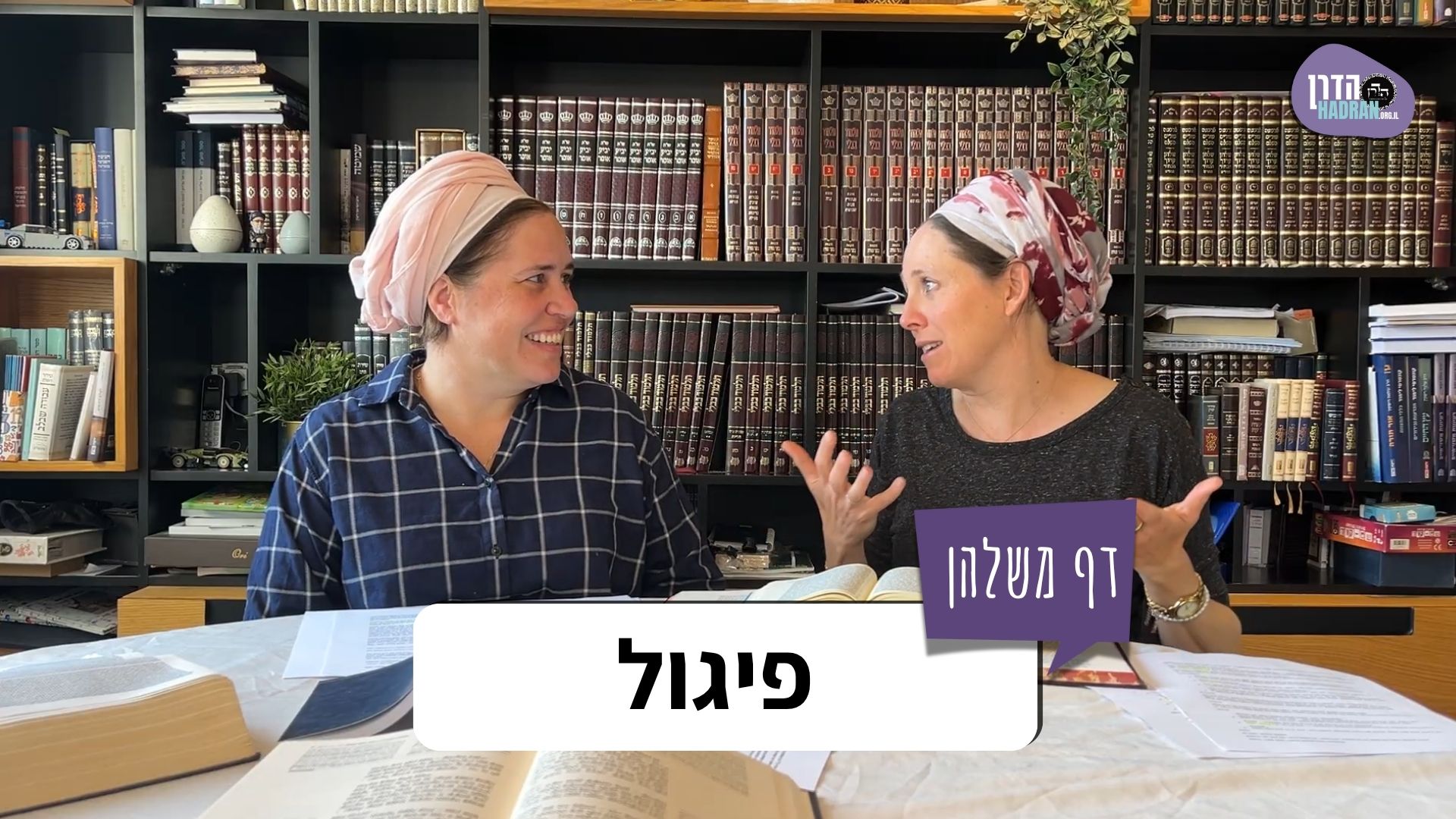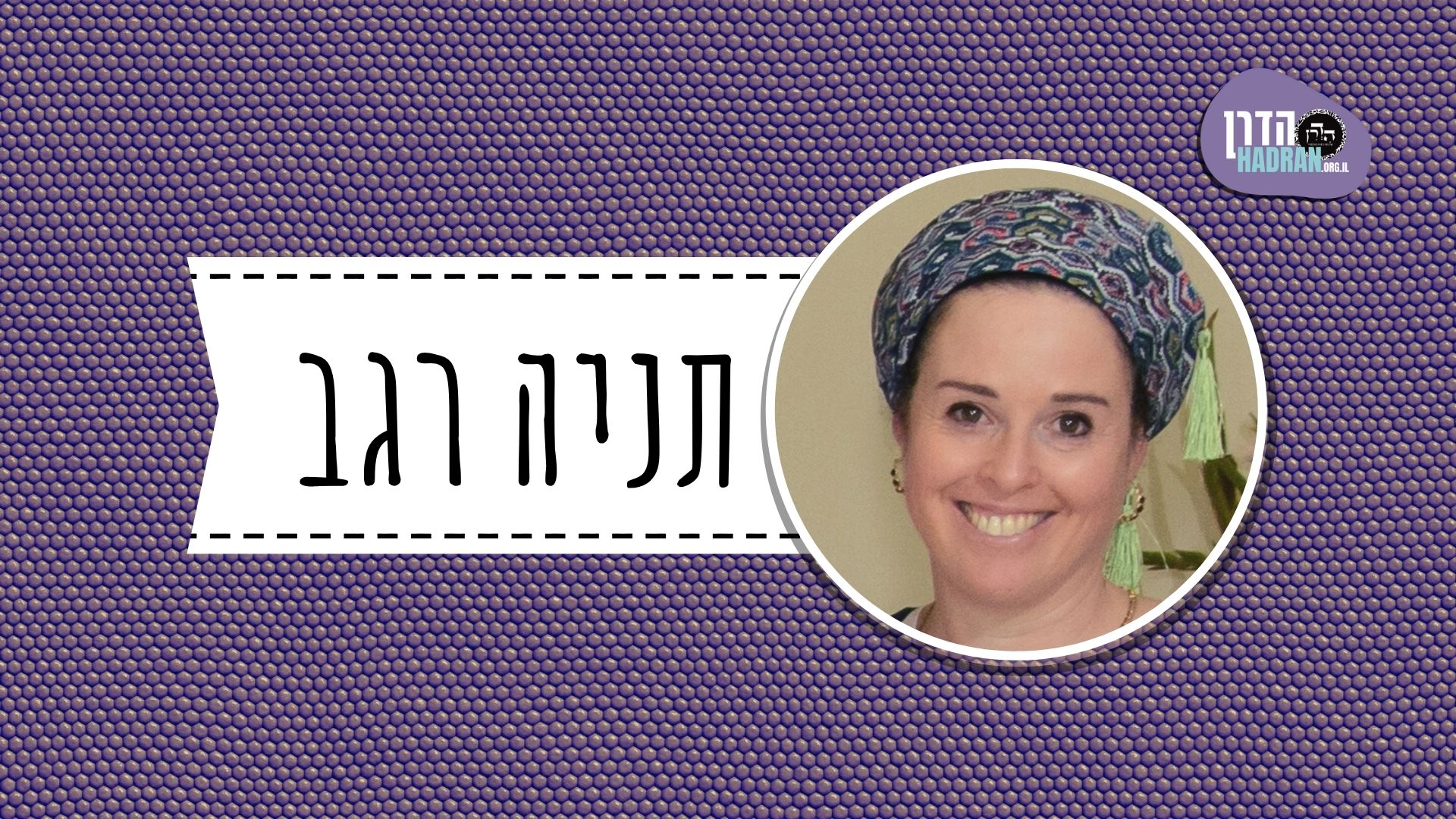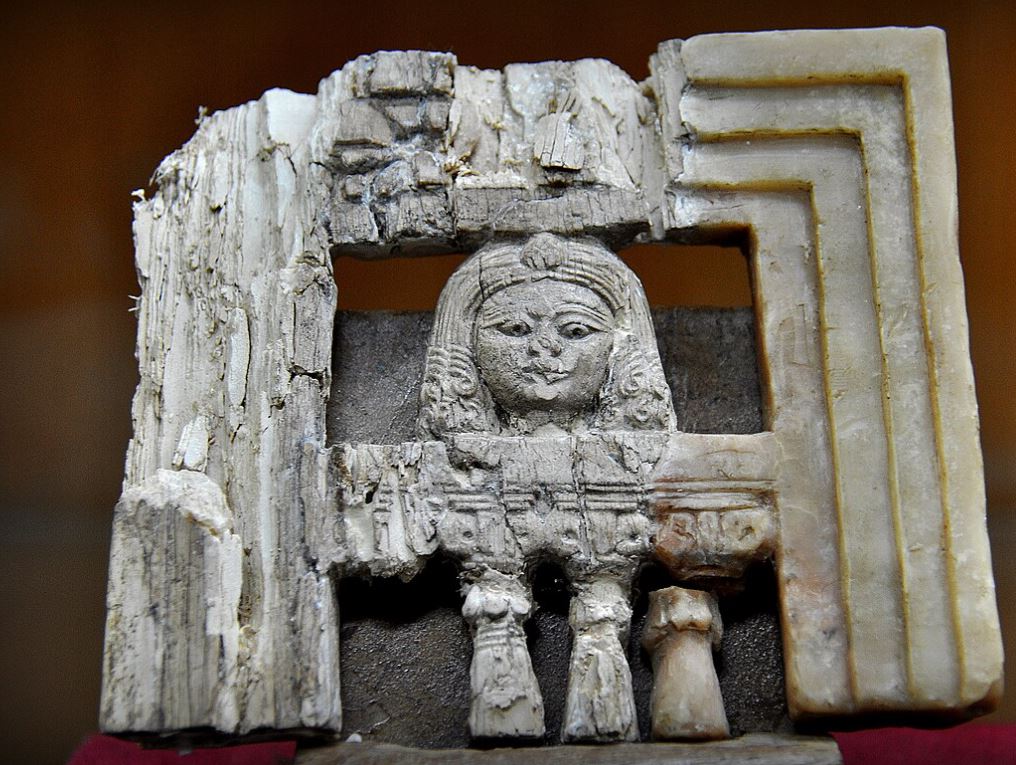From where do we derive that the kmitza has to be done with the right hand?
This month’s learning is sponsored by Beth Balkany in honor of their granddaughter, Devorah Chana Serach Eichel. “May she grow up to be a lifelong learner.”
Want to dedicate learning? Get started here:

This month’s learning is sponsored by Beth Balkany in honor of their granddaughter, Devorah Chana Serach Eichel. “May she grow up to be a lifelong learner.”
Delve Deeper
Broaden your understanding of the topics on this daf with classes and podcasts from top women Talmud scholars.
New to Talmud?
Check out our resources designed to help you navigate a page of Talmud – and study at the pace, level and style that fits you.
The Hadran Women’s Tapestry
Meet the diverse women learning Gemara at Hadran and hear their stories.
Menachot 10
(דהא כתב על דם האשם) חד להכשיר צדדין וחד לפסול צידי צדדין
After all, a verse already indicates that the oil must be placed on the right thumb and big toe, as it is written: “Upon the blood of the guilt offering” (Leviticus 14:17). Since the Torah has already specified that the blood is placed upon the right thumb and big toe (Leviticus 14:14), it is clear that the oil is placed there as well. Similarly, why must the verse specify with regard to a poor leper that the oil is placed on the right thumb and big toe? Isn’t already clear from the verse where the oil must be placed, as it states: “Upon the place of the blood of the guilt offering” (Leviticus 14:28)? The Gemara responds: One specification, stated with regard to a wealthy leper, serves to permit the placement of the oil on the sides of the thumb and sides of the big toe in addition to the nail side of the thumb and big toe, and one, stated with regard to a poor leper, serves to disqualify the sides of sides, i.e., their undersides.
(ויקרא יד, יז) על דם האשם על מקום דם האשם למאי אתו
The Gemara inquires with regard to the verse: “Upon the blood of the guilt offering” (Leviticus 14:17), stated with regard to the purification of a wealthy leper, and the verse: “Upon the place of the blood of the guilt offering” (Leviticus 14:28), stated with regard to the purification of a poor leper. For what purpose do they come, i.e., why are both verses necessary?
הני צריכי אי כתב רחמנא על דם האשם הוה אמינא איתיה אין נתקנח לא כתב רחמנא על מקום
The Gemara responds: These verses are necessary, because if the Merciful One had written only: “Upon the blood of the guilt offering,” I would say: If the blood is still on the right thumb and big toe of the leper, yes, the priest places the oil upon the blood. But if it was wiped from there, he does not place the oil. Therefore, the Merciful One writes: “Upon the place of the blood of the guilt offering,” indicating that the oil is placed upon the location of the blood, not necessarily upon the blood itself.
ואי כתב רחמנא על מקום הוה אמינא דוקא נתקנח אבל איתיה אימא הוי חציצה קמ”ל על דם האשם:
And conversely, if the Merciful One had written only: “Upon the place of the blood of the guilt offering,” I would say: The oil is placed on his right thumb and big toe specifically when the blood was wiped from there. But if the blood is still there, I will say that the blood is an interposition between the oil and the thumb or toe. Therefore, the verse teaches us that the oil is placed “upon the blood of the guilt offering,” and the blood is not considered an interposition.
אמר רבא מאחר דכתיב על דם האשם ועל מקום [דם] האשם וכתיבא ימנית בדם על בהן ידו הימנית ועל בהן רגלו הימנית וכתיבי בשמן דמצורע עשיר ועני למה לי
Rava said: Since it is written that the priest places the oil “upon the blood of the guilt offering,” and: “Upon the place of the blood of the guilt offering,” and it is also written with regard to a wealthy leper (see Leviticus 14:14) and a poor one (see Leviticus 14:25) that the right hand and foot are required for the placement of the blood, as the verses state: “Upon the thumb of his right hand, and upon the big toe of his right foot,” and this is also written with regard to the oil of a wealthy leper (see Leviticus 14:17) and a poor one (see Leviticus 14:28), one can ask: Why do I need all of these verses?
אלא אמר רבא יד יד לקמיצה
Rather, Rava said: The verses that specify that the oil must be placed on the right thumb and big toe do not teach a halakha with regard to a leper, as it is clear that the oil must be placed on the right thumb and big toe, as it states: “Upon the place of the blood of the guilt offering.” Rather, these verses are the source of verbal analogies for other halakhot. When the verse states with regard to a wealthy leper: “Of his right hand” (Leviticus 14:17), this teaches a verbal analogy between the term “hand” written here and “hand” written with regard to the removal of a handful, as the verse states about the removal of a handful: “And he filled his hand from it” (Leviticus 9:17). The verbal analogy teaches that the removal of the handful must also be performed with the right hand.
רגל רגל לחליצה
Similarly, when the verse states: “Of his right foot” (Leviticus 14:17), with regard to a wealthy leper, this teaches a verbal analogy between the term “foot” written here and “foot” written with regard to the ritual through which the yavam, a man whose married brother died childless, frees his brother’s widow, the yevama, of her levirate bonds [ḥalitza], as the verse states with regard to ḥalitza: “And remove his shoe from upon his foot” (Deuteronomy 25:9). The verbal analogy teaches that the shoe is removed from his right foot.
אוזן אוזן לרציעה
Additionally, when the verse states: “Upon the tip of the right ear of him that is to be cleansed” (Leviticus 14:17), with regard to a wealthy leper, this teaches a verbal analogy between the term “ear” written here and “ear” written with regard to the piercing of a Hebrew slave’s ear with an awl, as the verse states: “And his master shall bore his ear through with an awl” (Exodus 21:6). The verbal analogy teaches that the slave’s right ear is pierced.
שמאלית (העני) למאי אתא אמר רב שישא בריה דרב אידי ליפסול ימין דכהן במצורע שלא תאמר ומה במקום שלא נתרבתה שמאל נתרבתה ימין במקום שנתרבתה שמאל אינו דין שנתרבתה ימין
The Gemara asks: With regard to the additional mention of the left hand in the verse dealing with the poor leper, for what purpose does it come? Rav Sheisha, son of Rav Idi, said: It comes to disqualify the right hand of a priest for the purification of a leper. This teaches that you should not say: And if in a place where the left side is not included, as sacrificial rites in general are disqualified when performed with the left hand, the right hand is included, i.e., those rites must be performed with the right hand, then in a place where the left hand is included, in the case of a leper, isn’t it logical that the right hand should also be included? Therefore, the verse repeats that the oil is poured into the priest’s left hand, in order to disqualify the right hand.
ואידך שמאלית ויד ורגל ימנית דעני למאי אתא לכדתנא דבי ר’ ישמעאל כל פרשה שנאמרה ונשנית לא נשנית אלא בשביל דבר שנתחדש בה
The Gemara asks: And concerning the other verses that specify the left hand of a poor leper (Leviticus 14:26–27) as well as the right hand and foot of a poor leper (Leviticus 14:25–28), for what purpose do they come? The Gemara responds: These verses come for that which the school of Rabbi Yishmael taught: Any passage that was stated in the Torah and was then repeated, was repeated only for the sake of a matter that was introduced for the first time in the repeated passage. That is, sometimes the Torah repeats an entire passage just to teach a single new detail. In this case, the verses that discuss the purification of a poor leper were repeated only for the sake of the differences in the offerings between a wealthy leper and a poor one. No additional halakha should be derived from them.
אמר רבה בר בר חנה אמר ר’ שמעון בן לקיש כל מקום שנאמרה אצבע וכהונה אינה אלא ימין
§ Rabba bar bar Ḥana says that Rabbi Shimon ben Lakish says: Any place in the Torah in which it is stated that an action is performed with a finger or by the priesthood, i.e., that one uses his finger to perform the action or that a priest performs it, this teaches that it is performed only with the right hand.
קס”ד אצבע וכהונה בעינן כדכתיב (ויקרא ד, כה) ולקח הכהן מדם החטאת באצבעו וגמר ממצורע דכתיב (ויקרא יד, טז) וטבל הכהן את אצבעו הימנית הרי קמיצה דלא כתיבא בה אלא כהונה ותנן קמץ בשמאל פסול
The Gemara comments: It might enter our mind to say that this means that we require both a finger and the priesthood to be stated together in the verse in order to mandate use of the right hand, e.g., as it is written: “And the priest shall take of the blood of the sin offering with his finger” (Leviticus 4:25). And the fact that this verse is referring to a finger from his right hand is derived from a leper, as it is written: “And the priest shall dip his right finger” (Leviticus 14:16). This cannot be correct, as there is the verse that addresses the removal of a handful from a meal offering, in which only the priesthood is written, and yet we learned in a mishna (6a): If the priest removed the handful with his left hand the meal offering is unfit.
אמר רבא או אצבע או כהונה
Therefore, Rava said: This statement means that if the verse mentions either a finger or the priesthood, only the right hand may be used.
אמר ליה אביי הרי הולכת אברים לכבש דכתיב בהו כהונה דכתיב (ויקרא א, יג) והקריב הכהן את הכל המזבחה ואמר מר זו הולכת אברים לכבש ותנן הרגל של ימין בשמאל ובית עורה לחוץ
Abaye said to Rava: But this is contradicted by the verse discussing the conveyance of the limbs of the daily burnt offering to the ramp of the altar, as priesthood is written with regard to it, as it is written: “And the priest shall sacrifice the whole and make it smoke upon the altar” (Leviticus 1:13), and the Master said that this verse is referring to the conveyance of the limbs to the ramp. And yet we learned in a mishna (Tamid 31b): When the priest conveys the limbs to the ramp, the foot of the right side of the offering is carried in the left hand of the priest, and the place of its skin, i.e., the side of the limb covered in skin, is held facing outward. Clearly, use of the left hand does not disqualify the conveyance of the limbs.
כי אמרי’ או אצבע או כהונה בדבר המעכב כפרה
The Gemara responds: When we say that if the verse states either finger or priesthood then the left hand is disqualified, this is only with regard to a matter that precludes atonement, i.e., a rite whose performance is indispensable to the atonement, similar to the sprinkling of the oil on the leper (see Leviticus 14:16). The conveyance of the limbs, by contrast, is not indispensable to atonement.
והרי קבלה דבר המעכב כפרה הוא וכתב בה כהונה דכתיב (ויקרא א, ה) והקריבו בני אהרן הכהנים את הדם זו קבלת הדם ותנן קבל בשמאל פסל ורבי שמעון מכשיר
The Gemara asks: But isn’t there the collection of the blood in a service vessel, which is a matter indispensable to atonement, and about which priesthood is written? As it is written: “And Aaron’s sons, the priests, shall present the blood” (Leviticus 1:5), and this is referring to the collection of the blood. And yet we learned in a mishna (Zevaḥim 15b): If one collected the blood with his left hand, the blood is disqualified for offering, and Rabbi Shimon deems it fit, despite the fact that priesthood is mentioned in the verse.
The Gemara responds: You are saying that there is a difficulty according to the opinion of Rabbi Shimon? Rabbi Shimon requires that both matters appear in the verse, i.e., both finger and priesthood.
ומי בעי רבי שמעון תרתי והתניא ר”ש אומר כל מקום שנאמרה יד אינה אלא ימין אצבע אינה אלא ימין אצבע לא בעיא כהונה כהונ’ בעי’ אצבע
The Gemara asks: And does Rabbi Shimon really require both? But isn’t it taught in a baraita: Rabbi Shimon says: In any place in the Torah in which the word hand is stated, the verse is referring only to the right hand, and whenever a verse mentions the word finger, it is referring only to a finger of the right hand? The Gemara responds: According to Rabbi Shimon, if the verse mentions only the word finger, it does not require a mention of the priesthood as well for the limitation to apply. But if the verse mentions only the priesthood, it requires mention of the term finger for the limitation to apply.
אלא כהן למה לי בכהונו
The Gemara asks: But according to Rabbi Shimon, if the mention of the priesthood alone does not suffice to disqualify the right hand, then why do I need the superfluous reference to a priest with regard to the collection of the blood? After all, the verse already states that the collection must be performed by the sons of Aaron. The Gemara responds: The additional mention of the priesthood indicates that a priest must perform the collection of the blood in his priestly state, i.e., while wearing the priestly vestments.
והרי זריקה דלא כתב ביה אלא כהונה ותנן זרק בשמאל פסול ולא פליג ר’ שמעון אמר אביי פליג בברייתא דתניא קבל בשמאל פסול ור”ש מכשיר זרק בשמאל פסול ורבי שמעון מכשיר
The Gemara asks: But isn’t there the sprinkling of the blood, concerning which only the priesthood is written in the verse, and we learned: If one sprinkled the blood with his left hand it is disqualified; and Rabbi Shimon does not disagree with this ruling, indicating that Rabbi Shimon holds that a mention of the priesthood does not require a mention of the word finger? Abaye says: He disagrees with this ruling in a baraita, as it is taught in a baraita: If one collected the blood with his left hand it is disqualified, and Rabbi Shimon deems it fit. Additionally, if one sprinkled the blood with his left hand it is disqualified, and Rabbi Shimon deems it fit.
ואלא הא דאמר רבא יד יד לקמיצה למה לי מכהונה נפקא
The Gemara asks: But that which Rava says with regard to the superfluous terms in the passage discussing a leper: One derives a verbal analogy between the word “hand” written in that passage and the word “hand” written with regard to the removal of a handful from a meal offering, to indicate that the latter must also be performed with the right hand, why do I need this verbal analogy? One can derive that the handful must be removed with the right hand from the verse’s mention of the priesthood, as it is stated: “And the priest shall remove his handful” (Leviticus 5:12).
חד לקומץ וחד לקידוש קומץ
The Gemara responds: Both derivations are necessary, one for the removal of the handful from a meal offering, and one for the sanctification of the handful, i.e., placing it into a second service vessel. Both must be performed with the right hand.
לרבי שמעון דלא בעי קידוש קומץ ולמאן דאמר נמי דבעי קידוש קומץ לר’ שמעון ובשמאל אכשורי מכשר יד יד דרבא למה לי
The Gemara asks: And according to Rabbi Shimon, who does not require sanctification of the handful, or according to the one who says that Rabbi Shimon also requires the sanctification of the handful but that he deems the sanctification fit when performed with the left hand (see 26a), why do I need the verbal analogy of Rava between “hand” and “hand”?
אי לקמיצה גופה אליבא דר’ שמעון מדר’ יהודה בריה דר’ חייא נפקא דאמר ר’ יהודה בריה דר’ חייא מאי טעמא דר”ש דאמר קרא (ויקרא ו, י) קדש קדשים היא כחטאת וכאשם
If one suggests that it is necessary to indicate that the removal of the handful itself must be performed with the right hand, this cannot be, since this is derived from the verse cited by Rabbi Yehuda, son of Rabbi Ḥiyya. As Rabbi Yehuda, son of Rabbi Ḥiyya, says: What is the reason that Rabbi Shimon does not require that the handful be sanctified in a service vessel? As the verse states with regard to the meal offering: “It is most holy, as the sin offering, and as the guilt offering” (Leviticus 6:10).
בא לעובדה ביד עובדה בימין כחטאת בא לעובדה בכלי עובדה בשמאל כאשם
Rabbi Yehuda, son of Rabbi Ḥiyya, elaborates: The verse compares the meal offering to a sin offering and a guilt offering. Therefore, if the priest comes to perform the burning of the handful with his hand, he performs it with his right hand, like in the case of a sin offering, whose blood is sprinkled with the hand. And if he comes to perform it with a vessel, i.e., if he first sanctifies the handful in a service vessel, then he may perform it with his left hand, like in the case of a guilt offering, whose blood is sprinkled from a vessel. Since the removal of the handful is performed with the hand, the verse indicates that it must be performed with the right hand, and the verbal analogy is unnecessary.
לא נצרכא אלא לקומץ דמנחת חוטא סלקא דעתך אמינא הואיל ואמר רבי שמעון שלא יהא קרבנו מהודר כי קמיץ לה נמי בשמאל תתכשר קמשמע לן:
The Gemara responds: The verbal analogy is necessary only for the handful of the meal offering of a sinner, to teach that it must be removed with the right hand. It might enter your mind to say: Since Rabbi Shimon says that this offering does not require oil and frankincense so that a sinner’s offering will not be of superior quality, perhaps when the priest removed the handful with his left hand, which is a manner of inferior quality, it should be fit as well. The verbal analogy therefore teaches us that the handful must always be removed with the right hand, even in the case of the meal offering of a sinner.
קמץ ועלה בידו צרור או גרגר מלח
§ The mishna teaches: If a priest removed the handful of flour, and a stone or a grain of salt emerged in his hand,






























